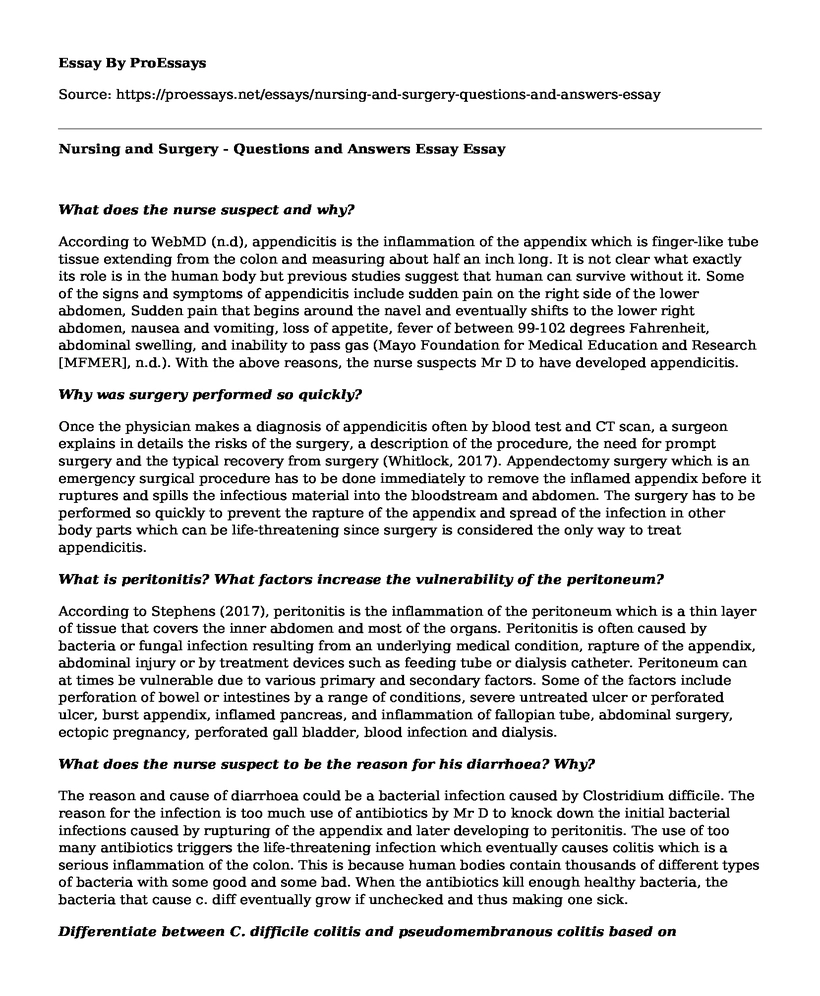What does the nurse suspect and why?
According to WebMD (n.d), appendicitis is the inflammation of the appendix which is finger-like tube tissue extending from the colon and measuring about half an inch long. It is not clear what exactly its role is in the human body but previous studies suggest that human can survive without it. Some of the signs and symptoms of appendicitis include sudden pain on the right side of the lower abdomen, Sudden pain that begins around the navel and eventually shifts to the lower right abdomen, nausea and vomiting, loss of appetite, fever of between 99-102 degrees Fahrenheit, abdominal swelling, and inability to pass gas (Mayo Foundation for Medical Education and Research [MFMER], n.d.). With the above reasons, the nurse suspects Mr D to have developed appendicitis.
Why was surgery performed so quickly?
Once the physician makes a diagnosis of appendicitis often by blood test and CT scan, a surgeon explains in details the risks of the surgery, a description of the procedure, the need for prompt surgery and the typical recovery from surgery (Whitlock, 2017). Appendectomy surgery which is an emergency surgical procedure has to be done immediately to remove the inflamed appendix before it ruptures and spills the infectious material into the bloodstream and abdomen. The surgery has to be performed so quickly to prevent the rapture of the appendix and spread of the infection in other body parts which can be life-threatening since surgery is considered the only way to treat appendicitis.
What is peritonitis? What factors increase the vulnerability of the peritoneum?
According to Stephens (2017), peritonitis is the inflammation of the peritoneum which is a thin layer of tissue that covers the inner abdomen and most of the organs. Peritonitis is often caused by bacteria or fungal infection resulting from an underlying medical condition, rapture of the appendix, abdominal injury or by treatment devices such as feeding tube or dialysis catheter. Peritoneum can at times be vulnerable due to various primary and secondary factors. Some of the factors include perforation of bowel or intestines by a range of conditions, severe untreated ulcer or perforated ulcer, burst appendix, inflamed pancreas, and inflammation of fallopian tube, abdominal surgery, ectopic pregnancy, perforated gall bladder, blood infection and dialysis.
What does the nurse suspect to be the reason for his diarrhoea? Why?
The reason and cause of diarrhoea could be a bacterial infection caused by Clostridium difficile. The reason for the infection is too much use of antibiotics by Mr D to knock down the initial bacterial infections caused by rupturing of the appendix and later developing to peritonitis. The use of too many antibiotics triggers the life-threatening infection which eventually causes colitis which is a serious inflammation of the colon. This is because human bodies contain thousands of different types of bacteria with some good and some bad. When the antibiotics kill enough healthy bacteria, the bacteria that cause c. diff eventually grow if unchecked and thus making one sick.
Differentiate between C. difficile colitis and pseudomembranous colitis based on symptoms. Compare and contrast the two, with a particular focus on the differences.
While Pseudomembranous colitis is often due to Clostridium difficile infection, some of their symptoms differ. For instance, some of the symptoms of pseudomembranous colitis include abnormal cramps, pain or tenderness, pus or mucus in stool, and normal watery diarrhoea. Symptoms of pseudomembranous colitis often begin as soon as one starts taking antibiotics or as long as several months after completion of taking antibiotics. On the other hand, the symptoms of c. difficile colitis includes watery diarrhoea 10 to 15 times a day, mild abdominal cramping, rapid heart rate, loss of appetite, blood or pus in stools, weight loss, swollen abdomen, kidney failure and increased white blood cell count. The major difference between pseudomembranous colitis and C. difficile colitis is that c. difficile is caused by the use of antibiotics while pseudomembranous colitis has a variety of causes and c. difficle is just one of them (Tang, Urrunaga, & Von Rosenvinge, 2016).
References
Mayo Foundation for Medical Education and Research. (n.d.). Appendicitis. Retrieved from https://www.mayoclinic.org/diseases-conditions/appendicitis/symptoms-causes/syc-20369543Stephens, C. (2017). Peritonitis. Retrieved from https://www.healthline.com/health/peritonitis
Tang, D. M., Urrunaga, N. H., & Von Rosenvinge, E. C. (2016). Pseudomembranous colitis: not always Clostridium difficile. Cleve Clin J Med, 83(5), 361-366. Retreived from https://www.mdedge.com/ccjm/article/108370/critical-care/pseudomembranous-colitis-not-always-clostridium-difficile
WebMD. (n.d.). Appendicitis. Retrieved from https://www.webmd.com/digestive-disorders/digestive-diseases-appendicitis#1
Whitlock, J. (2017). Appendicitis and Appendectomy Before, During and After Surgery. Retrieved from https://www.verywellhealth.com/appendectomy-surgery-3157269
Cite this page
Nursing and Surgery - Questions and Answers Essay. (2022, Nov 29). Retrieved from https://proessays.net/essays/nursing-and-surgery-questions-and-answers-essay
If you are the original author of this essay and no longer wish to have it published on the ProEssays website, please click below to request its removal:
- The Deception of Participants Implying the Transgression of the Informed Consent Norm
- Nursing Theorists Annotated Bibliography
- ICU Ethics Essay
- Abortion Coverage Debate Paper Example
- Essay on Reasons as to Why the HIPAA was Deemed Necessary in the Mid-1990s
- Paper Example on Alcohol Use Disorder: Identifying Risk with AUDIT & T-ACE
- Free Essay Example on Breast Cancer







